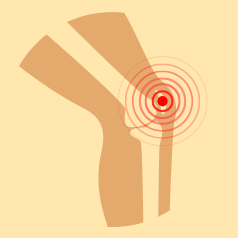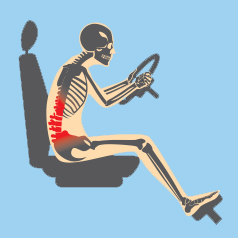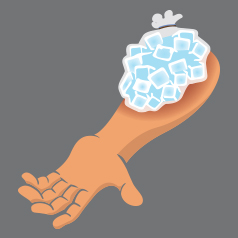Pain Science: An Interview with Paul Ingraham

Paul Ingraham is a writer and former Registered Massage Therapist in Vancouver, Canada. Frustrated by pseudoscience in that profession, he quit to write full-time, which has worked out well: he now makes a living publishing a self-help website about musculoskeletal medicine and chronic pain, PainScience.com. He offers hundreds of free articles, a huge bibliography, and ebook sales generate the revenue that keeps the lights on, about tricky problems like back pain or running and overuse injuries like plantar fasciitis and patellofemoral pain. Several more of his greatest hits are linked throughout this wide-ranging interview.
Tim Arndt: Your website is mostly about the science of aches and pains. Did you ever expect to have such a vast and popular website about this subject?
Paul Ingraham: Not the foggiest notion for at least the first half dozen years of writing. The earliest content was online by 2001, and by 2005 there was some traffic, but I still really had no idea what I was up to or what it could become. I kind of felt like the Cylons in Battlestar Galactica, who supposedly had a plan and they were certainly up to something, but exactly what was always a mystery. It wasn't until about 2008 that I started to make a little money and had a reasonably clear picture of what I hoped PainScience.com could become, and I didn't actually achieve it for another couple years.
So it was a long process, with many stages between "clueless" and "okay, I know what this is all about now." Even now I still often feel like the tail is wagging the dog.
What is the purpose of your website? What will people learn by visiting it?
The purpose of the website is to educate ordinary people about the science of aches, pains, and injuries, and help them apply it to their own problems as much as possible. If I can make them chuckle along the way, so much the better. By happy coincidence, this style of writing is also useful for many professionals, especially personal trainers and massage practitioners.
I love your website and it's my go-to resource when I have clients with aches and pains. I've learned quite a bit about how pain works and it's actually helped me to understand my client's pain better and how to work with it and around it during exercise. One of the biggest things I've learned from your website is how pain works. Seems it's more of a mind game than most people think. Can you give us a brief description of how pain works?

Crucially, pain is not an automatic response to damaged tissue. When we hurt, we immediately want to know why: what's broken? What's diseased? What tissue is in trouble? But it's incredibly hard to interpret. Your brain is the boss of your mind, and it decides whether or not there's pain based on all kinds of information about the situation that your conscious mind does not and cannot ever have access to. The key implication of this is that pain is weird and unpredictable, a lot more than most people realize. The world of pain science is a bit surreal. It's the quantum mechanics of biology.
That kind of speaks to how people have different pain tolerances doesn't it? For example, if I fall and scrape my knee I'll get up and brush it off and continue with whatever I was doing. But if my brother does the same thing he cries and limps around as if he blew his ACL. To me this is just a scratch so my brain doesn't sense any danger, or whatever, and therefore the pain is minimal, but my brother sees it as a life ending event, therefore he may actually experience more pain. Right?
Right. The experience of pain is the output of an extremely complex and mostly invisible and unknowable equation. The same thing will hurt us more or less, or for longer or not as long, because of things like: how it's going to affect our employment, whether our spouse is sympathetic, how much stress we've soaked up over the last three years, what kind of movie we saw last night, whether the stimulus reminds us of an old injury, how hungry or tired we are, and on and on and on, countless other possibilities. Behind the concept of "pain tolerance" are many variables we cannot know. And the whole system can get screwed up: "central sensitization" is brutal.
Since you're a former masseuse I have to ask, personally I hate it when I get a massage and they start digging their elbows into my muscles. It hurts! I want to relax when I get a massage, but they always insist on it saying that they're gonna "fix me up." What are they trying to accomplish and does it actually work?
Massage practitioners who say that kind of thing mostly don't know exactly what they are trying to accomplish, but they think they do. I see a lot of hubris in the form of elaborate, but biologically illiterate post hoc rationalizations, especially concerning the manipulation of connective tissues: they are trying to "release" something, usually, to fix something that is "stuck" in some sense. But the truth is that no direct biological benefit of strong massage has ever been demonstrated. As far as anyone can tell, it can't fix or change anything tangible.
About the only thing that's certain is that deep tissue massage generates a lot of interesting sensations. That can be very useful and meaningful, depending on the intensity and how the patient reacts to it. But mostly they are great for dramatic effect — for making it seem like something important is happening, and for making a big psychological impression on the patient. Placebo fuel, basically.
I got a massage the other day and was able to fall asleep. It was awesome! Anyhow, let's switch gears a little bit. It seems everybody is worried about bad posture and saying it will cause enormous amounts of pain and basically make your life miserable. But you state through various articles on your website that it's really not something to worry about. Why?

The evidence is strong that posture is a relatively minor factor in pain. We're tougher than we think. Pain just isn't driven by relatively subtle biomechanics. Unusual postural strain can be problematic, but most people's postural habits just aren't that serious. Pain has other, sneakier causes!
So what do you say about the whole "sitting is the new smoking" thing? I'm guessing you disagree.
It's hyperbole to make an interesting point about the potential hazards of a sedentary lifestyle. There's no way it's going to turn out to be literally true, because smoking is about as unhealthy as lighting yourself on fire, and sitting is never really going to compete with it. But the interesting idea behind the hyperbole is that sitting, like smoking, may hurt us even if we go play after work every day. The smoker is screwed even if they run 5km every night, and maybe the sitter is screwed too, just not as much.
The problem is, the danger hasn't actually been proven yet. It might be true to some degree, it might not. So it's not so much that I disagree as I just think it's important not to indulge in any fear mongering about sitting still until we have better data.
Probably my favorite article on your site is "Quite a Stretch." I've shared it with just about every single one of my clients because they all think they need to stretch to remain limber. This isn't really the case is it?
No it is not. Flexibility is overrated, just like good posture. Gymnasts and acrobats need it, the average person doesn't. Most people need greater power and control throughout their existing range of motion: that's much more useful for performance and injury prevention.
Another critical concept is that stiffness is a sensation, not a physical property. People think they need to be more flexible because they feel stiff, but that sensation is rarely related to actually limited range of motion. Stiffness is more like a kind of chronic pain, difficult to troubleshoot, much more complicated than range of motion.
One criticism I've heard about that article is that it debunks the importance of stretching, but doesn't provide any alternatives. What do you say about that?
Yes, that's a common criticism from people who get upset and never actually read past the first few paragraphs! I do suggest alternatives. For instance, I discuss the good evidence that warmups are useful for preventing injury, even if stretching isn't. And I'm a huge fan of resistance training and promote it enthusiastically on PainScience.com, because it's all kinds of evidence-based goodness — even for increasing flexibility, interestingly!
I also make it clear how much I like the sensations of stretching and discuss why they might be valuable. I don't say stretching is useless, only that the conventional reasons given for doing it are wrong.
OK, so let's say I'm flexible enough to do what I need to do to live and have no plans to become a contortionist, I don't need to stretch. But what if I like to because it feels good? Am I setting myself up for injury?
Any movement that feels good is inherently worthwhile. But you could never stretch, ever, and it would have no effect whatsoever injury risk. That's what the science shows so far, and it shows it well enough that I doubt it's going to change.
Epsom salts. People love their salt baths. I know you've received some interesting "fan" mail from your article on Epsom salts. I've never had a salt bath so I'm clueless as to what makes them so glorious. Can you fill me in? What's the real deal about salt baths? Do they actually do anything?
People think that Epsom salts baths detoxify by osmosis which is good for pain… and every part of that idea is just junk. Epsom salts make water feel silky and smooth, which is a sensory treat. The magnesium may or may not actually get absorbed, but definitely not by osmosis, and the evidence on absorption is conflicting. The detox claim is just biologically illiterate. And as for treating pain, if magnesium can get from bath to bloodstream, there's still no known effect on any common kind of pain. That doesn't mean it's impossible, but it's probably a limited effect on a small and specific kind of pain problem — the majority of aches and pains will be unfazed.
Let's say that I don't care what you say and I'm going to still take my salt baths. Do I have to buy Epsom salt or can I just fill up my bath tub and pour salt in there from my pantry?
Very different kind of salt! In (weak) theory it's the magnesium in Epsom salts that you want. I don't think good ol' sodium chloride makes a bath feel silky either.
Gotcha! There's great debate about the use of ice or heat to treat pain and injuries and, of course, it's another pain related topic you've covered quite extensively. So let's pretend I sprained my ankle typing this question (with my weak ankles this might actually be possible), what do I do? Go get an ice pack or put it in the microwave?
Wow, you must have an interesting typing style!
It's ridiculous how easily I can sprain an ankle.

Put an ice pack on it initially, mostly to take the edge off the pain. Some experts are out there earnestly debunking ice, calling it the wrong thing to do, because inflammation is natural and therefore healthy and shouldn't be interfered with… but there are some good rebuttals to that. Diarrhea is natural too, but sometimes it still needs to be controlled! And you don't have to ice for any reason other than a bit of soothing analgesia: ice can just be a pain killer, it doesn't have to be complicated to be valuable. Heat would probably piss it off a bit, unnecessarily exacerbating the inflammation.
It seems that people forget that there are a lot of natural things that aren't that great for you. Like tornadoes, poisonous berries, and sprained ankles, lol.
Yes, and it's always tempting to point out how ridiculously dangerous nature can be. There are many great examples like that. But then there are also things that aren't "good" or "bad" but "it depends." Water's a good example: natural! But you can poison and kill yourself if you drink too much of it, and people have done that.
The most interesting article I've read on your site recently is about the placebo effect and the hype that surrounds it. Most people aren't aware of how placebo actually works so can you tell us a little bit about how it works and why it might be over-hyped?
I love that article, but placebo science is really in the deep end of the pool. Remember earlier in the interview, what I said about pain being "weird"? That there's a lot of mind game? Well, placebo is where the weird pain rubber hits the psychosomatic road. Everyone thinks placebo is "powerful," and there's some truth in that, especially when it comes to treating pain — which involves much more of a mind game than most pathology. But the unfortunate truth is that placebo is not actually all that powerful, and it has generally been over-hyped, often with an ideological agenda: as a sneaky way of enhancing the credibility of snake oil and quackery that can only offer placebo, especially homeopathy and acupuncture. A lot of so-called placebo is not a potent mind-over-matter effect at all, and its real powers are quite limited. It's a very, very complicated topic though.
I heard that any affect you get from placebo actually goes away over time if the treatment doesn't actually work. Is that true?
I'm sure that can happen, but I wouldn't expect it to be true of all placebos by a long shot. People can pretty easily ignore a lack of results, if their faith is strong. Exhibit A: prayer!
It would depend on a lot. If nothing interferes with the faith that a placebo is built on, it should be as persistent as any other kind of faith. The stronger the faith, the longer lasting the effect, regardless of whether the treatment is effective or not. But certainly things can break the faith, and persistence of pain is a big one.
OK, last question. You have so much free information on your website it's ridiculous. I seriously don't know how you keep up with it. But you also have 8 tutorials that you sell. Can you tell us a little bit about them and why people should buy them versus just digging around on your website?
I can't keep up with everything! But I'm always looking for the most important updates, so it works out.
All my tutorials started out as articles that I just kept adding to — more ideas, more science — until they were book-sized web pages. And then I put a price tag on them. People buy them because it's "one stop shopping" for the information they need. They're sick of the crazy mess that is online health care info — mostly short articles, poorly written, rarely referenced, conflicting advice, and so on — and then they find one of my pages, and (hopefully) it's like a breath of fresh air. Clear, credible, thorough, and it just keeps going, keeps answering questions… Yahtzee.
But there are two catches: it isn't free, and it doesn't promise a cure!
Well, I can tell you that was the case for me. I found a link to your stretching article and enjoyed how thorough and well referenced it was. I was hooked immediately. It didn't take long before I purchased your tutorials either, which are fantastic by the way.
Thanks for your time, Paul. I know you're busy trying to keep up with your website so it's greatly appreciated.
Thank you!































